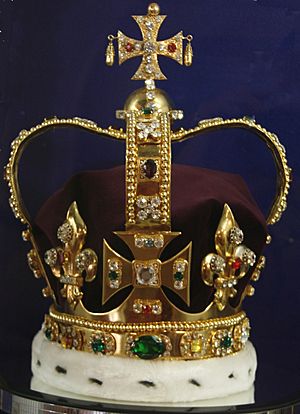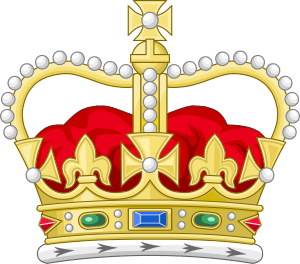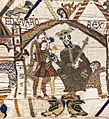St. Edward's Crown facts for kids
The St. Edward's Crown is a very important part of the coronation ceremony for British kings and queens. It's one of the most famous and valuable crown jewels. This special crown was first made for King Charles II's coronation way back on April 23, 1661. A royal jeweler named Robert Viner created it.
The crown we see today is mostly the same one made in 1661. It's crafted from solid gold and weighs quite a bit, about 2.2 kilograms (71 ounces). For coronations, it used to be decorated with real, rented jewels. After the ceremony, these were replaced with fake ones for display. But in 1911, the crown was permanently set with 444 real, beautiful semi-precious stones.
Contents
St. Edward's Crown: A Royal Treasure
What is the Crown?
St. Edward's Crown is a key piece of the royal regalia. These are the special items used during a king or queen's coronation. The crown is named after Edward the Confessor, an English king who lived a long time ago. The original crown was destroyed, so this one was made to replace it.
For a while, after King William III's coronation in 1689, this crown wasn't always placed on the monarch's head. It was often just carried in parades or placed on the altar. Another crown, called the Imperial State Crown, was used for the actual crowning. But in 1911, when King George V was crowned, St. Edward's Crown returned to its important role.
A Look Inside: What's It Made Of?
The main frame of St. Edward's Crown dates back to 1661. It's possible that parts of it might even be from an older crown. The crown is made from many different valuable materials.
These materials include:
- Gold
- Silver
- Platinum
- Enamel (a glassy coating)
- Tourmalines (colorful gemstones)
- Topazes (another type of gemstone)
- Rubies (red gemstones)
- Amethysts (purple gemstones)
- Sapphires (blue gemstones)
- Garnet (dark red gemstones)
- Peridot (green gemstones)
- Zircons (sparkling gemstones)
- Spinel (various colored gemstones)
- Aquamarines (blue-green gemstones)
- Velvet (a soft fabric)
- Ermine (a type of fur)
The Crowning Moment
The coronation ceremony is a very grand event. When it's time for the crowning, the Archbishop of Canterbury plays a special role. The Archbishop is the most senior bishop in the Church of England.
Here's what happens:
- The Archbishop carefully takes St. Edward's Crown from the altar.
- They then gently place it onto the new King or Queen's head.
- As the crown is placed, everyone shouts, "God save the King!" or "God save the Queen!"
- Princes, princesses, and other important people called peers and peeresses then put on their own smaller crowns, called coronets, and special caps.
- Trumpets blast loudly, and a special gun salute is fired at the Tower of London.
- After being crowned, the monarch sits on a throne.
- Finally, the clergy (church leaders), princes, and peers show their respect and loyalty to the new ruler.
Images for kids
-
King Edward the Confessor wearing a crown in the first scene of the Bayeux Tapestry
-
St. Edward's Crown as it looked at the coronation of James II of England in 1685
See also
 In Spanish: Corona de San Eduardo para niños
In Spanish: Corona de San Eduardo para niños





